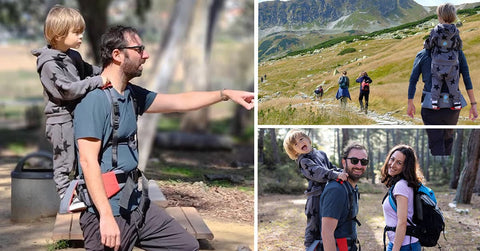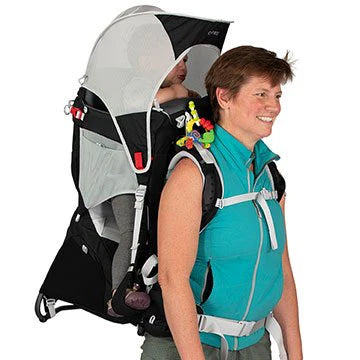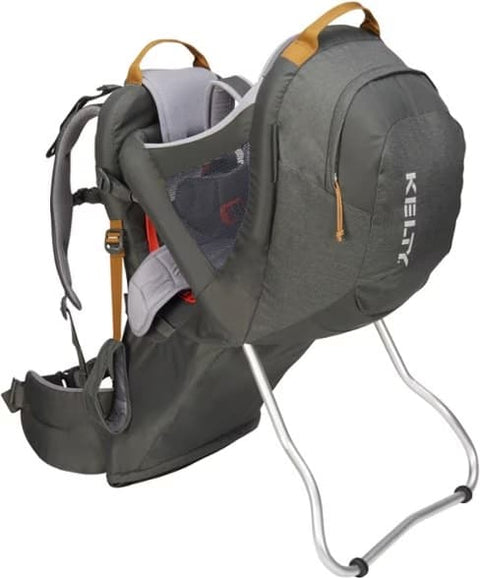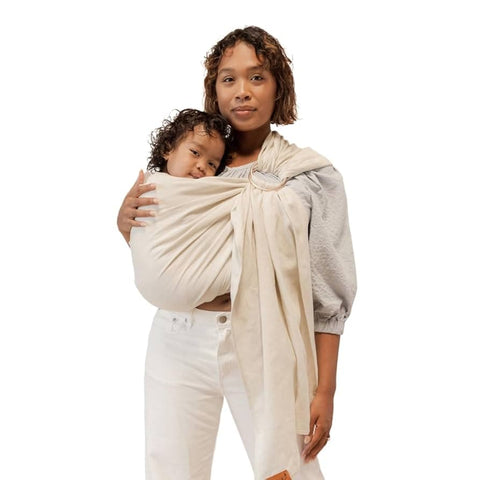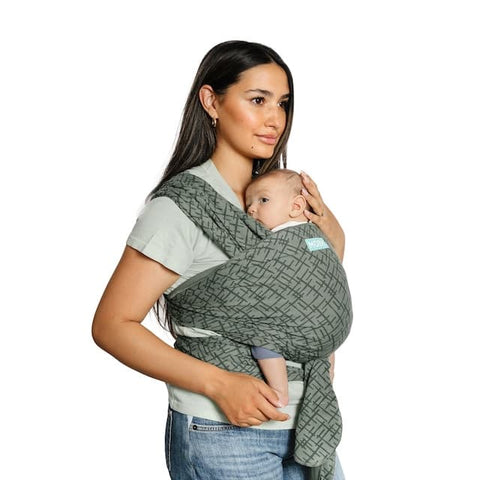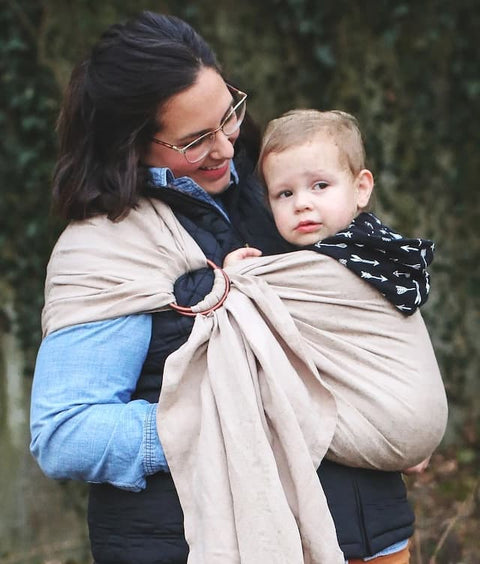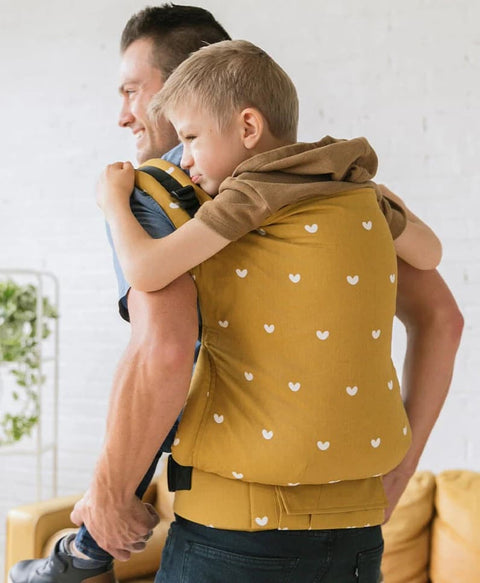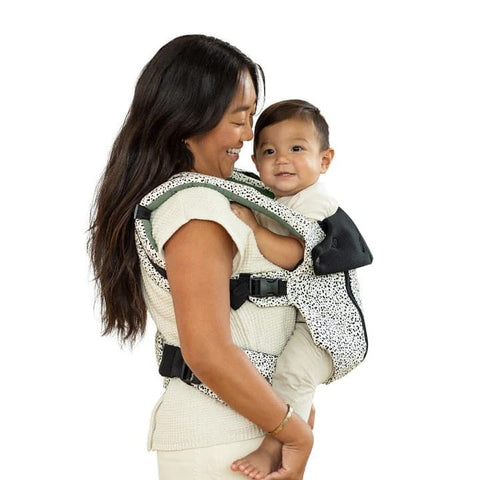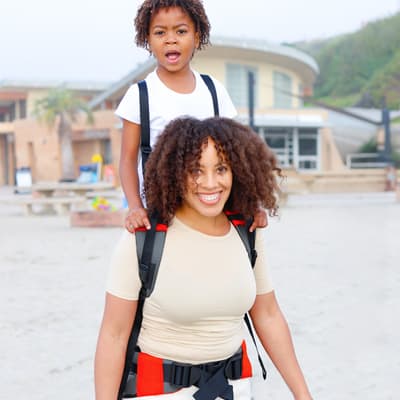
Best Hiking Carriers for 3 Year Olds
Exploring the great outdoors with your toddler can be a rewarding experience and an incredible opportunity to create lasting family memories. Yet, as parents, we are all cognizant and possibly slightly worried about managing our loved ones' little legs on long days out.
Three is a fantastic age. Kids are so much more active, inquisitive, energetic, and mobile. They need to run, walk, explore, and have adventures. But their legs are still shorter than ours, their batteries smaller, and their energy wanes before ours. So we need to plan on carrying them at some point. Either periodically during the day to keep them going, or at least for the last hour, when headed back to the car.
Choosing a child carrier for a 3-year-old (and many 2-year-olds) is a different challenge than choosing for younger kids. The size, weight, and usage patterns have all changed, making the right choice a little more critical. Let's break down the new challenges:
- Weight: The average 3-year-old boy weighs 32 lbs (14 kg), that's six bags of potatoes! Carrying this much weight unsupported leads to back pain, arm ache, and can quickly tire an adult. This leads parents to dread carrying, avoid carrying, experience stress, weather tantrums, and postpone longer days out. Proper support for an adult's back when carrying their child becomes vitally important as the child gets older and heavier. Look for carriers with solutions for transferring weight away from the back. Additionally, the best traditional child carriers have a limited range for larger, heavier kids, with weight restrictions of 30lbs - 40lbs, restrictions that a 3-year-old will soon outgrow.
Read article: Standing Piggyback Carrier vs. Traditional Carriers
- Size: Your child isn't just getting heavier, they are also taller, with longer limbs. The comfort of the child and the parent can be impacted simply by the size of the child. In a seated carrier, either a traditional framed carrier or a soft-structured carrier, where do the kids' long arms and legs go? Are the arms dangling down the side, are their feet rhythmically knocking the backs of the parents' legs?
- Activity: Your 3-year-old enjoys the running, the exploring, and the freedom their new mobility gives them. You do not expect to be carrying them all day, all the time. They are not inclined to sit in a padded throne on your shoulders for hours on end. Their latest activity level needs to be considered when choosing your next toddler or preschool carrier. Kids above the age of 2 have a lot of energy, but still need to be carried intermittently, or to be carried for parents' peace of mind (e.g., festivals, crowded plazas, airports, etc). Hence, a child carrier that is quick and hassle-free to climb on and off is a must-have feature. The easier and more seamless it is for your child to go from walking to riding, and back to walking again, the less stress and the less hassled you will feel.
- Engagement: On a grand day out, even though your kid's legs are tired, their brain is not. Choose a preschool carrier, or a hiking carrier, that enables them to continue engaging with the world and with you. Don't miss out on the amazing shared experiences and conversations when the child carrier elevates the kid's view, and does not bury it in your back.
Choosing a Hiking Carrier for 3 Year Olds
Thus, choosing the right hiking carrier for a 3-year-old is crucial. It ensures a pleasant experience for everyone involved. It can remove stress, hassle, tantrums, and back pain, and can extend a great day out. The right carrier can make all the difference. You are looking for a preschool carrier, or maybe a hiking carrier that:
- Transfers the child's weight effectively to your hips. Away from your back. Look for carriers with internal frames or other intentional weight transfer solutions. Look at the back posture needed when carrying - ensure the back is straight, the parent is balanced and mobile.
Read article: Child Carriers That Can Save Your Spine (2025)
- Ergonomically designed for bigger kids. Look where the legs and especially the feet go.
- Ease of use. The carrier must be quick and hassle-free to climb on and off. The easier and more seamless it is for your child to go from walking to riding, and back to walking again, the more you will use the carrier.
- Packs Up Small. Optional. If you are travelling or would prefer not to wear the child carrier all day, when it is not in use, look for a hiking carrier that can pack away into your day-bag, backpack, or carry-on. This is usually the winning feature of soft-structured carriers (SSCs).
There are many options available on the market. Each offers unique features and benefits. Finding the best fit for your family is important. Comfort is a top priority when selecting a hiking carrier. Look for adjustable harnesses and padded straps, and a supportive waistbelt is essential.
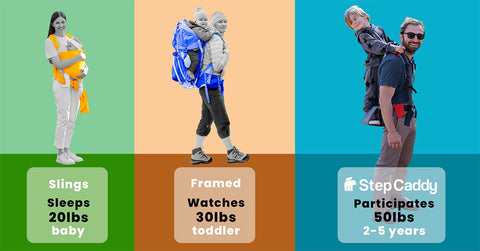
Different Types of Hiking Carrier
1. Big Framed Carriers
Big framed carriers are the classic heavy-duty choice for adventurous parents taking their little explorers on the trail. Built around a sturdy metal frame, these carriers excel at distributing your child's weight evenly, making them ideal for longer hikes. Big-framed child carriers are built like hiking backpacks, with a serious upgrade. They typically feature a rigid aluminum or steel frame that keeps the carrier upright when placed on the ground, making it easier to load and unload your child safely. These carriers often include padded shoulder straps, an adjustable hip belt, and a sternum strap to distribute your child’s weight evenly across your torso and hips. Many come with a built-in sunshade, storage compartments for snacks and gear, and adjustable seating positions to support growing kids. But, alas, they do not fit 5-year-old children. These carriers usually aim to accommodate children aged 1-3, but preschoolers outgrow them in height, weight, and temperament.
Ages:
Up to 3 years, or 30-40lbs.
Pros:
Excellent weight distribution with an internal frame that channels the child's weight to a load-bearing waistbelt. The carrier is bulky, but ventilation is good, utilizing mesh panels around the frame to keep the wearer's back aired. Additional storage is usually excellent, with compartments for snacks and gear; you must have this since you are wearing this carrier all day. Finally, despite being bulky and heavy, the comfort is excellent, achieved with heavily padded and adjustable straps, waistbelt, and adjustable seating for the child's comfort.
Cons:
As stated, it is bulky and heavy, making portability very poor. It will consume half your car trunk space. You do not need to pack it away, because you will be wearing it all day. Despite clever mechanisms that enable the carrier to stand on its frame, getting in and out is involved and time-consuming. Balance & Mobility is relatively good, effective weight transference helps, but the sitting weight is still high up the torso.
Examples:
2. Sling Carriers
Sling carriers offer simplicity, convenience, and unmatched intimacy when hiking with infants or very young toddlers. They're made from soft, flexible fabric that gently cradles your child close to your body. Perfect for shorter trails or quick adventures where speed and ease are paramount.
Ages:
Up to 3 years
Pros:
Lightweight, easily packable, promotes closeness and bonding, and is simple to use without complex adjustments.
Cons:
Slings offer no weight transfer mechanism to the hips, placing all the weight onto the shoulders, neck, and back. The uneven weight distribution causes potential shoulder strain, back strain, poor posture, and is generally suitable only for younger children and babies. There is no ventilation, which can cause discomfort and overheating in the adult.
Examples:
3. Soft Structured Carriers
Soft structure carriers combine comfort, versatility, and convenience into a balanced, backpack-like design that's great for moderate adventures. They feature padded straps, ergonomic designs, and often multiple carrying positions, adapting as your child grows from infant to toddler.
Ages:
Up to 3 years
Pros:
Versatile and adjustable, ergonomic support for parent and child, relatively lightweight and packable, and suitable for various ages.
Cons:
A less effective weight transfer mechanism than framed carriers, still leaves a significant amount of weight on your shoulders and back. This is not an issue for small toddlers, but for a three-year-old, this is a concern and may become uncomfortable during extended hikes due to this moderate weight distribution. Less ventilation compared to framed carriers, and limited storage. The ease of use is poor and usually requires the assistance of a second adult.
https://www.youtube.com/watch?v=vBTZAp3cF8k (thanks to Raising Hikers for the demonstration).
Examples:
4. The Step Caddy Carrier
Step Caddy is a unique innovation that reimagines the piggyback ride into a safe, comfortable, and portable experience tailored specifically for hiking adventures with toddlers and preschoolers. It combines comfort, versatility, and convenience into a balanced, backpack-like design that's great for short and long adventures. Unlike all other carriers in this article, it provides a standing platform, allowing children more freedom and a fun vantage point, while significantly reducing the strain on parents.
Ages:
2-5 years
Pros:
- Saves Your Back: Step Caddy is based on biomechanics research, which is why it uses a special, patented load-bearing waistbelt combined with the piggyback rider standing position. These two elements combined create a low center-of-mass, an even lower weight transfer point, and thus totally eliminates strain from the adults arms, shoulders, and especially the back. As children get heavier, protecting the parent's back from poorly adjusted loads is increasingly important. The Step Caddy design enables the adult to keep a straight back, not angled forward or sideways, while the child's weight is transferred directly to the hips, which are literally built for load-bearing. StepCaddy creates an almost "weightless carrying experience."
Click Here: Interesting article on protecting the spine - Greater balance, stability and mobility: The higher the center of mass of the child, the more unstable the platform. You instinctively know this from carrying a child on your shoulders; don't lean over to far! With Step Caddy the weight is being transferred directly to the hips, the child stands putting their center of mass very close to the adults own normal center of mass - hence giving the adult normal levels of balance, stability, mobility, no back of strain, improved posture, on any terrain.
- Exceptional Ease-of-Use: By positioning your child in a natural standing "piggyback" stance and anchoring their weight through integrated stirrups in the waistbelt, the carrier creates an exceptionally low center-of-mass and the weight is transferred to the hips, which means it is so much easier to stand-up when they have climbed on.
- Eco Friendly Foams🌱: Algae-infused foam is a real innovation with practical, measurable benefits. Traditional foams rely heavily on petroleum-based polyols. Algae-infused foam replaces a portion of those polyols with algae-derived biomass, reducing the reliance on fossil fuels. Algae foams are lightweight, flexible, and breathable—making them ideal for outdoor activity gear. They have improved durability, bounce-back, and cushioning compared to traditional EVA or PU foams.
- Packs Up Small: so it can be taken anywhere, even just in case. So it is engineered to be supportive and firm where needed, comfortable with four layers of foam, and also to strategically fold so it can pack up small. Small enough to throw into your bag, trunk, or carry-on.
Cons:
Only hydration accessories options available at this time. The child is standing, so no option for sleeping if that is needed.
Examples:
How to Choose the Right Hiking Carrier for Your Family
Selecting the right hiking carrier for your family involves various considerations. The first aspect is comfort for both the parent and the child. A carrier with adjustable straps and ample padding ensures a snug fit. Next, consider your hiking habits and environments. Consider all the other potential uses and situations you will want to use the carrier - are you going travelling, to theme parks, or a festival?
Child Carriers are expensive; pick one that will accommodate all your needs.
Finally, think about additional features that we identified as important for a Hiking Carrier for a 3 Year Old:
- Transfers Weight to your hips
- Ergonomic for larger kids
- Ease of use
- Packs Up Small
Age Range | Weight Transfer | Ergonomic Design | Ease of Use | Packs Up Small | |
Big Framed Carrier | 1-3 yrs | Excellent | Excellent | Medium | Poor |
Soft Structured Carrier | 1-3 yrs | Medium | Excellent | Poor | Excellent |
Sling Carriers | 0-3 yrs | Poor | Medum | Excellent | Excellent |
Step Caddy Carrier | 2-5 yrs | Excellent | Excellent | Excellent | Excellent |
Frequently asked questions
Most hiking carriers are suitable for children aged six months up to three years. There are a few carriers that are designed for 4-year-olds, and 5-year-olds.
Age and the child's weight are both factors, so you must check the carrier specifications.
The carrier must distribute weight evenly. Adjust straps for both comfort and safety. Ensure your child is snugly seated, with no excessive movement. As stated in this article, for older kids, the need for proper weight distribution to the hips with a load-bearing waistbelt is vitally important for the adult's comfort, energy and spine health.
Yes, they are safe if used correctly. Choose carriers with certifications and safety features like a five-point harness. Regularly check for product recalls.
Absolutely! These carriers are versatile. Use them for travel, city tours, or even beach outings. They adapt to various environments and activities.
Regular cleaning and inspection are recommended. Check for damage after every hike. Follow the manufacturer's guidelines for specific maintenance requirements.
Conclusion: Making the Most of Your Hiking Adventures
Hiking with your 3-year-old can be a memorable experience, given the right carrier. Prioritize the features we identified as important for a Hiking Carrier for a 3 Year Old:
- Transfers Weight to your hips
- Ergonomic for larger kids
- Ease of use
- Packs Up Small
With a well-chosen hiking carrier, you open doors to family adventures. Explore trails, enjoy nature, and create lifelong memories together. Embrace the journey and the joy it brings.

